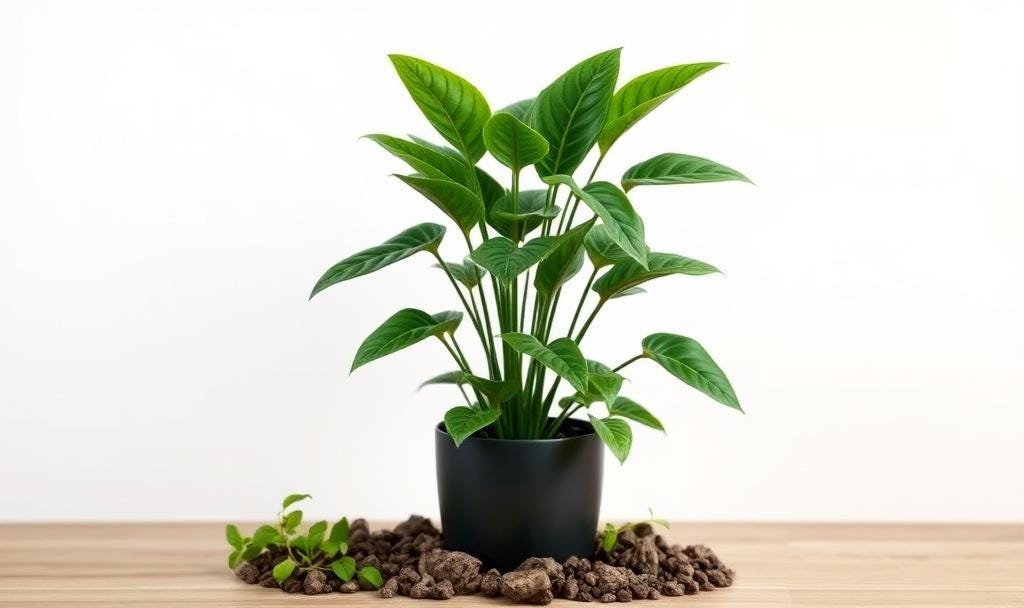What Plants Teach Us About Boundaries
🌿 A single plant, a simple lesson: how to protect your time, energy, and peace.
I used to think that being a caring person meant giving endlessly—time, energy, attention, love. If I poured enough of myself into people, projects, or even plants, everything would thrive. At least, that’s what I told myself.
But I learned the hard way that “too much” care can be just as harmful as too little. My first seedlings taught me this lesson: a beautiful set of tomato plants I nearly drowned with my eagerness. Every day I’d water them, certain that more water meant more love. Within weeks, their leaves turned brown, limp, and sad. I wasn’t neglecting it—I was smothering it.
Those seedlings gave me my first quiet lesson in boundaries. And since then, every plant I’ve cared for has reinforced the truth: healthy growth happens inside the balance of “just enough.”
The Quiet Lesson of Plants
Plants are boundary-keepers by nature. They don’t grow stronger because you hover over them every hour of the day. They don’t demand endless effort or sacrifice. All they do is ask for their needs.
Give a plant too much water, and its roots rot. Too little light, and it stretches weakly toward the sun. Too much fertilizer burns. Plants thrive within their limits.
Boundaries aren’t barriers. They’re the conditions for growth. A fern loves shade. A tomato loves the sun. One isn’t better than the other—they just have different needs, different lines in the sand. And when we respect those lines, they reward us with lush growth, blossoms, or fruit.
Over-giving vs. Under-giving
It’s tempting to think the worst thing we can do is neglect a plant. But over-giving can be just as destructive.
Over-watering is a metaphor I return to often: the way we flood situations with too much energy because we want to help, fix, or control the outcome. I’ve done it in relationships, in jobs, in friendships—giving more than was healthy for me, because I thought that’s what care looked like.
And just like with plants, under-giving carries its own risks. Sometimes we pull back too far—avoiding, ignoring, hoping things will sort themselves out. That’s when both plants and people wilt from lack of nourishment.
The truth is, health is all about balance. Neither over-watering nor neglect leads to growth. Instead, both extremes leave roots vulnerable. Plants remind us that balance isn’t about perfection—it’s about paying attention.
Learning to Say “No”
Pruning may be the hardest lesson in boundaries. Cutting back feels counterintuitive when you want a plant to flourish. Why remove green leaves or growing stems? But every gardener knows: pruning encourages stronger, healthier growth.
Without it, a plant wastes energy on spindly branches that never bear fruit.
Pruning is saying “no” to what drains vitality. In our lives, that might look like stepping away from commitments that no longer serve us, or gently pulling back from relationships that leave us depleted.
Saying no isn’t neglect—it’s a form of protection. It’s redirecting energy toward what matters most.
Plants teach us that letting go isn’t loss—it’s preparation for new growth.
Creating Safe Containers
When you pot a plant, you’re giving it a boundary: a container to grow within. That container protects it. It holds the soil and water it needs. It keeps the roots stable so the plant can focus on upward growth.
Without a container, a plant’s roots sprawl and weaken, unable to draw the necessary nutrients and water efficiently from an environment that won’t sustain it.
The human spirit, too, flourishes within well-defined parameters. Boundaries provide focus, allowing us to concentrate our efforts, manage our time, and achieve our goals with greater precision.
Without boundaries, our energy scatters in too many directions, leaving us feeling depleted and ineffective. A pot is not a prison, constricting growth and preventing it from reaching its full potential. A boundary is not a wall, designed to shut out opportunity and experience.
They are, instead, structures that say: This is the space where I can thrive.
In time, the plant may outgrow its container, its roots becoming densely packed, signaling a need for a bigger pot and a larger, richer environment to thrive.
Just like that plant, you may eventually outgrow your current boundaries, causing a reevaluation and expansion of the space in which you operate, constantly seeking opportunities for growth and development, embracing new challenges, and pushing your limits to reach your fullest potential.
Continuous growth and adjustment are vital for lasting wellness.
The Emotional Resonance
The more I tend plants, the more I notice how they mirror the lessons I need most in my own life.
When I care for a plant, I can’t demand it grow faster, taller, or in the way I want. I can’t force it to bloom on my schedule. My role is to listen, observe, and honor its needs.
Imagine if we treated ourselves with the same respect. Plants never apologize for needing more water or less light. They don’t feel guilty for outgrowing their pots. They simply exist as they are, communicating through their leaves, stems, and flowers.
What if we gave ourselves the same permission? To take up space. To say “this much water, no more.” To ask for light. To prune what doesn’t serve us. Plants teach us to normalize need without shame.
Bringing It Back to You
Here’s where you come in. I invite you to look at your own life through the lens of your plants.
Are you over-watering—giving too much of yourself to people or projects?
Are you under-watering—neglecting your own needs while tending to others?
Do you need pruning—letting go of what drains you so new growth can emerge?
Are you rootbound—cramped in a space too small for the person you’re becoming?
Pick one plant in your home and let it be your teacher. Watch how it asks for water, how it responds to sunlight, how it tells you what’s working and what’s not. Notice the boundaries it requires. Then ask yourself: where can I mirror this in my own life?
Closing Inspiration
Plants don’t just decorate our homes. They teach us how to live. They show us that boundaries aren’t harsh rules but gentle agreements that make growth possible.
Caring for plants reminds us to care for ourselves—not by giving endlessly, but by honoring the balance of enough. Not by holding everything in, but by creating safe spaces to expand. Not by saying yes to everything, but by pruning so our energy flows where it matters most.
This is the magic I want TriGardening to share: that a single plant, cared for with attention, can transform not just your space, but your life.
Plants whisper wisdom if you’re willing to listen.
-KC
P.S. If you think someone would benefit from this post, please share it with them by using the button below.



